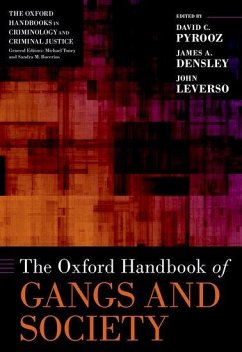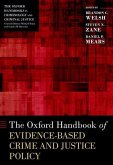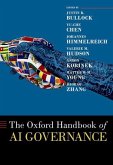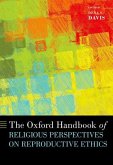- Gebundenes Buch
- Merkliste
- Auf die Merkliste
- Bewerten Bewerten
- Teilen
- Produkt teilen
- Produkterinnerung
- Produkterinnerung
The Oxford Handbook of Gangs and Society is the premier reference book on gangs for practitioners, policymakers, students, and scholars. This carefully curated volume contains 43 chapters written by the leading experts in the field, who advance a central theme of "looking back, moving forward" by providing state-of-the-art reviews of the literature they created, shaped, and (re)defined. This international, interdisciplinary collective of authors provides readers with a rare tour of the field in its entirety, expertly navigating thorny debates and the at-times contentious history of gang…mehr
Andere Kunden interessierten sich auch für
![The Oxford Handbook of Evidence-Based Crime and Justice Policy The Oxford Handbook of Evidence-Based Crime and Justice Policy]() Daniel P MearsThe Oxford Handbook of Evidence-Based Crime and Justice Policy209,99 €
Daniel P MearsThe Oxford Handbook of Evidence-Based Crime and Justice Policy209,99 €![The Oxford Handbook of Intergenerational Ethics The Oxford Handbook of Intergenerational Ethics]() GardinerThe Oxford Handbook of Intergenerational Ethics177,99 €
GardinerThe Oxford Handbook of Intergenerational Ethics177,99 €![The Oxford Handbook of Peace History The Oxford Handbook of Peace History]() The Oxford Handbook of Peace History224,99 €
The Oxford Handbook of Peace History224,99 €![The Oxford Handbook of AI Governance The Oxford Handbook of AI Governance]() The Oxford Handbook of AI Governance258,99 €
The Oxford Handbook of AI Governance258,99 €![The Oxford Handbook of Symbolic Interactionism The Oxford Handbook of Symbolic Interactionism]() The Oxford Handbook of Symbolic Interactionism209,99 €
The Oxford Handbook of Symbolic Interactionism209,99 €![The Oxford Handbook of Religious Perspectives on Reproductive Ethics The Oxford Handbook of Religious Perspectives on Reproductive Ethics]() The Oxford Handbook of Religious Perspectives on Reproductive Ethics230,99 €
The Oxford Handbook of Religious Perspectives on Reproductive Ethics230,99 €![The Oxford Handbook of Republicanism The Oxford Handbook of Republicanism]() SellersThe Oxford Handbook of Republicanism180,99 €
SellersThe Oxford Handbook of Republicanism180,99 €-
-
-
The Oxford Handbook of Gangs and Society is the premier reference book on gangs for practitioners, policymakers, students, and scholars. This carefully curated volume contains 43 chapters written by the leading experts in the field, who advance a central theme of "looking back, moving forward" by providing state-of-the-art reviews of the literature they created, shaped, and (re)defined. This international, interdisciplinary collective of authors provides readers with a rare tour of the field in its entirety, expertly navigating thorny debates and the at-times contentious history of gang research, while simultaneously synthesizing flourishing areas of study that advance the field into the 21st century.
Hinweis: Dieser Artikel kann nur an eine deutsche Lieferadresse ausgeliefert werden.
Hinweis: Dieser Artikel kann nur an eine deutsche Lieferadresse ausgeliefert werden.
Produktdetails
- Produktdetails
- Verlag: Hurst & Co.
- Seitenzahl: 920
- Erscheinungstermin: 6. Februar 2024
- Englisch
- Abmessung: 255mm x 177mm x 62mm
- Gewicht: 1642g
- ISBN-13: 9780197618158
- ISBN-10: 0197618154
- Artikelnr.: 67863283
- Herstellerkennzeichnung
- Libri GmbH
- Europaallee 1
- 36244 Bad Hersfeld
- gpsr@libri.de
- Verlag: Hurst & Co.
- Seitenzahl: 920
- Erscheinungstermin: 6. Februar 2024
- Englisch
- Abmessung: 255mm x 177mm x 62mm
- Gewicht: 1642g
- ISBN-13: 9780197618158
- ISBN-10: 0197618154
- Artikelnr.: 67863283
- Herstellerkennzeichnung
- Libri GmbH
- Europaallee 1
- 36244 Bad Hersfeld
- gpsr@libri.de
David Pyrooz is Professor of Sociology at the University of Colorado Boulder. He is the author of four books, including On Gangs and Competing for Control: Gangs and the Social Order of Prisons, the latter of which received the Outstanding Book Award from the Academy of Criminal Justice Sciences. James Densley is Professor and Department Chair of Criminology and Criminal Justice at Metro State University. Densley is the author of eight books, including How Gangs Work and On Gangs; more than 50 peer-reviewed articles in leading scientific journals; and over 100 book chapters, essays, and other works in outlets such as Time magazine, The Wall Street Journal, and The Washington Post. John Leverso is an Assistant Professor at the University of Cincinnati in the School of Criminal Justice. He is a sociological criminologist whose research investigates the urban street gang and later life consequences of justice involvement focusing on race/ethnicity, gender, and interactions on the digital street.
* 1. Introduction to the OUP Handbook of Gangs and Society
* David C. Pyrooz, James A. Densley, and John Leverso
* Section 1: Revisiting Definitions in the 21st Century
* 2. The Eurogang definition: Context, development, scrutiny, and
debate (including a conversation with Malcolm Klein)
* Frank Weerman and Scott Decker
* 3. What gangs aren't: Contrasting gangs with other collectives
* Martin Bouchard, Karine Descormiers, and Alysha Girn
* 4. A relational approach to street gangs
* Andrew V. Papachristos, John Leverso, and David Hureau
* 5. Gangs in practice: Violence prevention, law enforcement, and the
received idea of the "gang"
* David Kennedy
* 6. The social construction of the American street gang
* Patrick Lopez-Aguado
* 7. Gang identity across the life course
* Sou Lee and Bryan F. Bubolz
* 8. Place matters: Geographers and gang members
* Stefano Bloch
* Section 2: Approaches to the Empirical Study of Gangs
* 9. The history and evolution of gang scholarship: A topic modeling
and change point detection approach
* Jason Gravel
* 10. Funding gang research to advance policy and practice
* Phelan A. Wyrick, Barbara Tatem Kelley, and Mary Poulin Carlton
* 11. The National Youth Gang Survey: Past, present, and future
* Meagan Cahill, James C. Howell, and Arlen Egley Jr.
* 12. Historical gang research methods: An overview
* Mitchel Roth
* 13. Critical approaches to gangs
* Tilman Schwarze and Alistair Fraser
* 14. Women in gang research: An overview
* Marta-Marika Urbanik and Sandra M. Bucerius
* 15. Indigenous gangs and gang research
* Adrienne Freng and Hannah St. Clair
* 16. Studying gangs in Central and South America: Reflections on
gender and researcher positionality
* María José Méndez and Ellen Van Damme
* 17. Gang research in the Caribbean
* Edward R. Maguire
* Section 3: Core and Emerging Issues
* 18. What is gang culture? Three conceptualizations of an elusive
concept
* Caylin Louis Moore and Forrest Stuart
* 19. Masculinities and respect in the group context of gangs
* Lorine A. Hughes and Lisa M. Broidy
* 20. Birds of a feather? Individual differences and gang membership
* Jennifer J. Tostlebe and Jose Antonio Sanchez
* 21. Rational choice, gang membership, and crime: Moving actors and
choice to center stage
* Kyle J. Thomas
* 22. Psychopathology as a cause or consequence of youth gang
involvement
* Patricia K. Kerig, Lucybel Mendez, Ava Alexander, and Susan Chen
* 23. The emerging frontier: Gangs in developing countries
* Herbert C. Covey
* 24. Gang ecological diversity in the Hollenbeck area of Los Angeles,
1978-2012
* P. Jeffrey Brantingham and Matthew Valasik
* Section 4: Gangs in Institutional Context
* 25. Storming the capital: The place of street capital and social
capital within gangs
* Simon Harding and Ross Deuchar
* 26. On gangs and family: Primary, secondary, and surrogate family
* Gabriel T. Cesar, D'Andre Walker, and Tiffany Fernandez
* 27. Linking education and criminology research to understand the
schooling experiences of gang youth and adults
* Adrian H. Huerta
* 28. Religion and gangs: An introduction to the isolated and
integrated affiliation models
* Timothy R. Lauger and Haleigh Kubiniec
* 29. Re-examining the literature on social media and gangs: Critical
race theory as a path for new opportunities
* Caitlin Elsaesser and Desmond Patton
* 30. Comparative approaches to the study of prison gangs and prison
order
* David Skarbek and Kaitlyn Woltz
* 31. Transnational gangs? Understanding migration and gangs
* José Miguel Cruz and Jonathan D. Rosen
* Section 5: Legacies of Second-Generation Researchers
* 32. The legacy of Scott H. Decker
* David C. Pyrooz and Richard K. Moule Jr.
* 33. The legacy of Finn-Aage Esbensen
* Dena C. Carson, Adrienne Freng, Chris Melde, and Dana Peterson
* 34. The legacy of John M. Hagedorn
* Roberto R. Aspholm
* 35. The legacy of Cheryl L. Maxson
* Shannon E. Reid
* 36. The legacy of Joan W. Moore
* James Diego Vigil
* 37. The legacy of James Diego Vigil
* Mike Tapia and E. Mark Moreno
* Section 6: Responding to Gangs
* 38. Clinical intervention for gang-involved youth: Toward an
empirically validated model
* Paul Boxer, Joanna Kubik, and Stephanie Marcello
* 39. No public benefit: The Placentia gang injunction opposition
campaign
* Sean Garcia-Leys and Jesse Engel
* 40. "Somebody's watching me:" Surveying police surveillance of gangs
* Matthew Valasik and P. Jeffrey Brantingham
* 41. Policing gangs: Five reasons why traditional strategies fail
* Madeleine Novich
* 42. Defund the police? Considerations for reducing gang violence
* Anthony A. Braga, John M. MacDonald, and George Tita
* 43. Making sense of the models: Continuities and differences across
prominent gang/group gun violence intervention models
* Jesse Jannetta, Paige S. Thompson, and Lily Robin
* David C. Pyrooz, James A. Densley, and John Leverso
* Section 1: Revisiting Definitions in the 21st Century
* 2. The Eurogang definition: Context, development, scrutiny, and
debate (including a conversation with Malcolm Klein)
* Frank Weerman and Scott Decker
* 3. What gangs aren't: Contrasting gangs with other collectives
* Martin Bouchard, Karine Descormiers, and Alysha Girn
* 4. A relational approach to street gangs
* Andrew V. Papachristos, John Leverso, and David Hureau
* 5. Gangs in practice: Violence prevention, law enforcement, and the
received idea of the "gang"
* David Kennedy
* 6. The social construction of the American street gang
* Patrick Lopez-Aguado
* 7. Gang identity across the life course
* Sou Lee and Bryan F. Bubolz
* 8. Place matters: Geographers and gang members
* Stefano Bloch
* Section 2: Approaches to the Empirical Study of Gangs
* 9. The history and evolution of gang scholarship: A topic modeling
and change point detection approach
* Jason Gravel
* 10. Funding gang research to advance policy and practice
* Phelan A. Wyrick, Barbara Tatem Kelley, and Mary Poulin Carlton
* 11. The National Youth Gang Survey: Past, present, and future
* Meagan Cahill, James C. Howell, and Arlen Egley Jr.
* 12. Historical gang research methods: An overview
* Mitchel Roth
* 13. Critical approaches to gangs
* Tilman Schwarze and Alistair Fraser
* 14. Women in gang research: An overview
* Marta-Marika Urbanik and Sandra M. Bucerius
* 15. Indigenous gangs and gang research
* Adrienne Freng and Hannah St. Clair
* 16. Studying gangs in Central and South America: Reflections on
gender and researcher positionality
* María José Méndez and Ellen Van Damme
* 17. Gang research in the Caribbean
* Edward R. Maguire
* Section 3: Core and Emerging Issues
* 18. What is gang culture? Three conceptualizations of an elusive
concept
* Caylin Louis Moore and Forrest Stuart
* 19. Masculinities and respect in the group context of gangs
* Lorine A. Hughes and Lisa M. Broidy
* 20. Birds of a feather? Individual differences and gang membership
* Jennifer J. Tostlebe and Jose Antonio Sanchez
* 21. Rational choice, gang membership, and crime: Moving actors and
choice to center stage
* Kyle J. Thomas
* 22. Psychopathology as a cause or consequence of youth gang
involvement
* Patricia K. Kerig, Lucybel Mendez, Ava Alexander, and Susan Chen
* 23. The emerging frontier: Gangs in developing countries
* Herbert C. Covey
* 24. Gang ecological diversity in the Hollenbeck area of Los Angeles,
1978-2012
* P. Jeffrey Brantingham and Matthew Valasik
* Section 4: Gangs in Institutional Context
* 25. Storming the capital: The place of street capital and social
capital within gangs
* Simon Harding and Ross Deuchar
* 26. On gangs and family: Primary, secondary, and surrogate family
* Gabriel T. Cesar, D'Andre Walker, and Tiffany Fernandez
* 27. Linking education and criminology research to understand the
schooling experiences of gang youth and adults
* Adrian H. Huerta
* 28. Religion and gangs: An introduction to the isolated and
integrated affiliation models
* Timothy R. Lauger and Haleigh Kubiniec
* 29. Re-examining the literature on social media and gangs: Critical
race theory as a path for new opportunities
* Caitlin Elsaesser and Desmond Patton
* 30. Comparative approaches to the study of prison gangs and prison
order
* David Skarbek and Kaitlyn Woltz
* 31. Transnational gangs? Understanding migration and gangs
* José Miguel Cruz and Jonathan D. Rosen
* Section 5: Legacies of Second-Generation Researchers
* 32. The legacy of Scott H. Decker
* David C. Pyrooz and Richard K. Moule Jr.
* 33. The legacy of Finn-Aage Esbensen
* Dena C. Carson, Adrienne Freng, Chris Melde, and Dana Peterson
* 34. The legacy of John M. Hagedorn
* Roberto R. Aspholm
* 35. The legacy of Cheryl L. Maxson
* Shannon E. Reid
* 36. The legacy of Joan W. Moore
* James Diego Vigil
* 37. The legacy of James Diego Vigil
* Mike Tapia and E. Mark Moreno
* Section 6: Responding to Gangs
* 38. Clinical intervention for gang-involved youth: Toward an
empirically validated model
* Paul Boxer, Joanna Kubik, and Stephanie Marcello
* 39. No public benefit: The Placentia gang injunction opposition
campaign
* Sean Garcia-Leys and Jesse Engel
* 40. "Somebody's watching me:" Surveying police surveillance of gangs
* Matthew Valasik and P. Jeffrey Brantingham
* 41. Policing gangs: Five reasons why traditional strategies fail
* Madeleine Novich
* 42. Defund the police? Considerations for reducing gang violence
* Anthony A. Braga, John M. MacDonald, and George Tita
* 43. Making sense of the models: Continuities and differences across
prominent gang/group gun violence intervention models
* Jesse Jannetta, Paige S. Thompson, and Lily Robin
* 1. Introduction to the OUP Handbook of Gangs and Society
* David C. Pyrooz, James A. Densley, and John Leverso
* Section 1: Revisiting Definitions in the 21st Century
* 2. The Eurogang definition: Context, development, scrutiny, and
debate (including a conversation with Malcolm Klein)
* Frank Weerman and Scott Decker
* 3. What gangs aren't: Contrasting gangs with other collectives
* Martin Bouchard, Karine Descormiers, and Alysha Girn
* 4. A relational approach to street gangs
* Andrew V. Papachristos, John Leverso, and David Hureau
* 5. Gangs in practice: Violence prevention, law enforcement, and the
received idea of the "gang"
* David Kennedy
* 6. The social construction of the American street gang
* Patrick Lopez-Aguado
* 7. Gang identity across the life course
* Sou Lee and Bryan F. Bubolz
* 8. Place matters: Geographers and gang members
* Stefano Bloch
* Section 2: Approaches to the Empirical Study of Gangs
* 9. The history and evolution of gang scholarship: A topic modeling
and change point detection approach
* Jason Gravel
* 10. Funding gang research to advance policy and practice
* Phelan A. Wyrick, Barbara Tatem Kelley, and Mary Poulin Carlton
* 11. The National Youth Gang Survey: Past, present, and future
* Meagan Cahill, James C. Howell, and Arlen Egley Jr.
* 12. Historical gang research methods: An overview
* Mitchel Roth
* 13. Critical approaches to gangs
* Tilman Schwarze and Alistair Fraser
* 14. Women in gang research: An overview
* Marta-Marika Urbanik and Sandra M. Bucerius
* 15. Indigenous gangs and gang research
* Adrienne Freng and Hannah St. Clair
* 16. Studying gangs in Central and South America: Reflections on
gender and researcher positionality
* María José Méndez and Ellen Van Damme
* 17. Gang research in the Caribbean
* Edward R. Maguire
* Section 3: Core and Emerging Issues
* 18. What is gang culture? Three conceptualizations of an elusive
concept
* Caylin Louis Moore and Forrest Stuart
* 19. Masculinities and respect in the group context of gangs
* Lorine A. Hughes and Lisa M. Broidy
* 20. Birds of a feather? Individual differences and gang membership
* Jennifer J. Tostlebe and Jose Antonio Sanchez
* 21. Rational choice, gang membership, and crime: Moving actors and
choice to center stage
* Kyle J. Thomas
* 22. Psychopathology as a cause or consequence of youth gang
involvement
* Patricia K. Kerig, Lucybel Mendez, Ava Alexander, and Susan Chen
* 23. The emerging frontier: Gangs in developing countries
* Herbert C. Covey
* 24. Gang ecological diversity in the Hollenbeck area of Los Angeles,
1978-2012
* P. Jeffrey Brantingham and Matthew Valasik
* Section 4: Gangs in Institutional Context
* 25. Storming the capital: The place of street capital and social
capital within gangs
* Simon Harding and Ross Deuchar
* 26. On gangs and family: Primary, secondary, and surrogate family
* Gabriel T. Cesar, D'Andre Walker, and Tiffany Fernandez
* 27. Linking education and criminology research to understand the
schooling experiences of gang youth and adults
* Adrian H. Huerta
* 28. Religion and gangs: An introduction to the isolated and
integrated affiliation models
* Timothy R. Lauger and Haleigh Kubiniec
* 29. Re-examining the literature on social media and gangs: Critical
race theory as a path for new opportunities
* Caitlin Elsaesser and Desmond Patton
* 30. Comparative approaches to the study of prison gangs and prison
order
* David Skarbek and Kaitlyn Woltz
* 31. Transnational gangs? Understanding migration and gangs
* José Miguel Cruz and Jonathan D. Rosen
* Section 5: Legacies of Second-Generation Researchers
* 32. The legacy of Scott H. Decker
* David C. Pyrooz and Richard K. Moule Jr.
* 33. The legacy of Finn-Aage Esbensen
* Dena C. Carson, Adrienne Freng, Chris Melde, and Dana Peterson
* 34. The legacy of John M. Hagedorn
* Roberto R. Aspholm
* 35. The legacy of Cheryl L. Maxson
* Shannon E. Reid
* 36. The legacy of Joan W. Moore
* James Diego Vigil
* 37. The legacy of James Diego Vigil
* Mike Tapia and E. Mark Moreno
* Section 6: Responding to Gangs
* 38. Clinical intervention for gang-involved youth: Toward an
empirically validated model
* Paul Boxer, Joanna Kubik, and Stephanie Marcello
* 39. No public benefit: The Placentia gang injunction opposition
campaign
* Sean Garcia-Leys and Jesse Engel
* 40. "Somebody's watching me:" Surveying police surveillance of gangs
* Matthew Valasik and P. Jeffrey Brantingham
* 41. Policing gangs: Five reasons why traditional strategies fail
* Madeleine Novich
* 42. Defund the police? Considerations for reducing gang violence
* Anthony A. Braga, John M. MacDonald, and George Tita
* 43. Making sense of the models: Continuities and differences across
prominent gang/group gun violence intervention models
* Jesse Jannetta, Paige S. Thompson, and Lily Robin
* David C. Pyrooz, James A. Densley, and John Leverso
* Section 1: Revisiting Definitions in the 21st Century
* 2. The Eurogang definition: Context, development, scrutiny, and
debate (including a conversation with Malcolm Klein)
* Frank Weerman and Scott Decker
* 3. What gangs aren't: Contrasting gangs with other collectives
* Martin Bouchard, Karine Descormiers, and Alysha Girn
* 4. A relational approach to street gangs
* Andrew V. Papachristos, John Leverso, and David Hureau
* 5. Gangs in practice: Violence prevention, law enforcement, and the
received idea of the "gang"
* David Kennedy
* 6. The social construction of the American street gang
* Patrick Lopez-Aguado
* 7. Gang identity across the life course
* Sou Lee and Bryan F. Bubolz
* 8. Place matters: Geographers and gang members
* Stefano Bloch
* Section 2: Approaches to the Empirical Study of Gangs
* 9. The history and evolution of gang scholarship: A topic modeling
and change point detection approach
* Jason Gravel
* 10. Funding gang research to advance policy and practice
* Phelan A. Wyrick, Barbara Tatem Kelley, and Mary Poulin Carlton
* 11. The National Youth Gang Survey: Past, present, and future
* Meagan Cahill, James C. Howell, and Arlen Egley Jr.
* 12. Historical gang research methods: An overview
* Mitchel Roth
* 13. Critical approaches to gangs
* Tilman Schwarze and Alistair Fraser
* 14. Women in gang research: An overview
* Marta-Marika Urbanik and Sandra M. Bucerius
* 15. Indigenous gangs and gang research
* Adrienne Freng and Hannah St. Clair
* 16. Studying gangs in Central and South America: Reflections on
gender and researcher positionality
* María José Méndez and Ellen Van Damme
* 17. Gang research in the Caribbean
* Edward R. Maguire
* Section 3: Core and Emerging Issues
* 18. What is gang culture? Three conceptualizations of an elusive
concept
* Caylin Louis Moore and Forrest Stuart
* 19. Masculinities and respect in the group context of gangs
* Lorine A. Hughes and Lisa M. Broidy
* 20. Birds of a feather? Individual differences and gang membership
* Jennifer J. Tostlebe and Jose Antonio Sanchez
* 21. Rational choice, gang membership, and crime: Moving actors and
choice to center stage
* Kyle J. Thomas
* 22. Psychopathology as a cause or consequence of youth gang
involvement
* Patricia K. Kerig, Lucybel Mendez, Ava Alexander, and Susan Chen
* 23. The emerging frontier: Gangs in developing countries
* Herbert C. Covey
* 24. Gang ecological diversity in the Hollenbeck area of Los Angeles,
1978-2012
* P. Jeffrey Brantingham and Matthew Valasik
* Section 4: Gangs in Institutional Context
* 25. Storming the capital: The place of street capital and social
capital within gangs
* Simon Harding and Ross Deuchar
* 26. On gangs and family: Primary, secondary, and surrogate family
* Gabriel T. Cesar, D'Andre Walker, and Tiffany Fernandez
* 27. Linking education and criminology research to understand the
schooling experiences of gang youth and adults
* Adrian H. Huerta
* 28. Religion and gangs: An introduction to the isolated and
integrated affiliation models
* Timothy R. Lauger and Haleigh Kubiniec
* 29. Re-examining the literature on social media and gangs: Critical
race theory as a path for new opportunities
* Caitlin Elsaesser and Desmond Patton
* 30. Comparative approaches to the study of prison gangs and prison
order
* David Skarbek and Kaitlyn Woltz
* 31. Transnational gangs? Understanding migration and gangs
* José Miguel Cruz and Jonathan D. Rosen
* Section 5: Legacies of Second-Generation Researchers
* 32. The legacy of Scott H. Decker
* David C. Pyrooz and Richard K. Moule Jr.
* 33. The legacy of Finn-Aage Esbensen
* Dena C. Carson, Adrienne Freng, Chris Melde, and Dana Peterson
* 34. The legacy of John M. Hagedorn
* Roberto R. Aspholm
* 35. The legacy of Cheryl L. Maxson
* Shannon E. Reid
* 36. The legacy of Joan W. Moore
* James Diego Vigil
* 37. The legacy of James Diego Vigil
* Mike Tapia and E. Mark Moreno
* Section 6: Responding to Gangs
* 38. Clinical intervention for gang-involved youth: Toward an
empirically validated model
* Paul Boxer, Joanna Kubik, and Stephanie Marcello
* 39. No public benefit: The Placentia gang injunction opposition
campaign
* Sean Garcia-Leys and Jesse Engel
* 40. "Somebody's watching me:" Surveying police surveillance of gangs
* Matthew Valasik and P. Jeffrey Brantingham
* 41. Policing gangs: Five reasons why traditional strategies fail
* Madeleine Novich
* 42. Defund the police? Considerations for reducing gang violence
* Anthony A. Braga, John M. MacDonald, and George Tita
* 43. Making sense of the models: Continuities and differences across
prominent gang/group gun violence intervention models
* Jesse Jannetta, Paige S. Thompson, and Lily Robin








